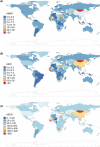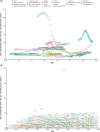The burden of primary liver cancer caused by specific etiologies from 1990 to 2019 at the global, regional, and national levels
- PMID: 34989144
- PMCID: PMC8894689
- DOI: 10.1002/cam4.4530
The burden of primary liver cancer caused by specific etiologies from 1990 to 2019 at the global, regional, and national levels
Abstract
Background: Liver cancer is one of the most common cancers worldwide. We aimed to report the burden of liver cancer at the global, regional, and national levels in 204 countries from 1990 to 2019, stratified by etiology, sex, age, and sociodemographic index (SDI).
Methods: Data of mortality, incidence, and disability-adjusted life years (DALYs) of liver cancer and its etiology were available from the Global Burden of Diseases, Injuries, and Risk Factors (GBD) Study 2019. The trends in the liver cancer burden were assessed by the annual percentage change. All estimates are presented as numbers and age-standardized rates (ASRs) per 100,000 population, with uncertainty intervals (UIs).
Results: Globally, 484,577 (95% UI 444,091-525,798) mortalities, 534,364 (486,550-588,639) incident cases, and 12,528,422 (11,400,671-13,687,675) disability-adjusted life years (DALYs) due to liver cancer occurred in 2019. The ASRs were 5.95 (5.44-6.44), 6.51 (5.95-7.16), and 151.08 (137.53-164.8) per 100,000 population for the mortalities, incidences, and DALYs, respectively. From 1990 to 2019, the numbers increased, whereas the ASRs decreased. Hepatitis B and Hepatitis C are the major causes of liver cancer mortality. The liver cancer mortality in 2019 increased with age, peaking at 65-69 and 70-74 age group in males and females, respectively, and the number was higher in males than in females. Generally, there were nonlinear associations between the ASR and SDIs values at the regional and national levels. China had the highest numbers of mortalities, incident cases, and DALYs, whereas Mongolia has the highest ASR in 2019.
Conclusion: Liver cancer remains a major public health issue worldwide, but etiological and geographical variations exist. It is necessary to increase awareness of the population regarding liver cancer, its etiologies and the importance of early detection, and diagnosis and treatment.
Keywords: disability-adjusted life years; global burden of disease; incidence; liver cancer; mortality.
© 2022 The Authors. Cancer Medicine published by John Wiley & Sons Ltd.
Conflict of interest statement
The authors declare no conflict of interest.
Figures






References
-
- Bray F, Ferlay J, Soerjomataram I, Siegel RL, Torre LA, Jemal A. Global cancer statistics 2018: GLOBOCAN estimates of incidence and mortality worldwide for 36 cancers in 185 countries. CA Cancer J Clin. 2018;68(6):394‐424. - PubMed
-
- SEER . Cancer Stat facts: liver and intrahepatic bile duct cancer. https://seer.cancer.gov/statfacts/html/livibd.html
-
- Choi J, Han S, Kim N, Lim YS. Increasing burden of liver cancer despite extensive use of antiviral agents in a hepatitis B virus‐endemic population. Hepatology (Baltimore, MD). 2017;66(5):1454‐1463. - PubMed
-
- Siegel RL, Miller KD, Colorectal cancer statistics, 2020. CA Cancer J Clin. 2020;70(3):145‐164. - PubMed
Publication types
MeSH terms
LinkOut - more resources
Full Text Sources
Medical

